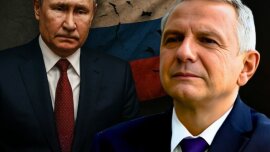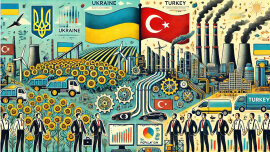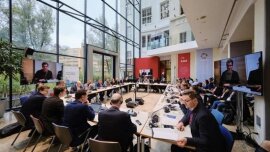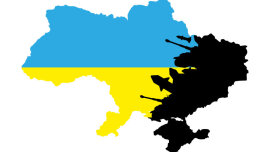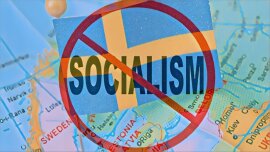Based on Solow's growth theory, output is determined by three factors: labor, capital, and technology.
Capital is subject to physical and moral deterioration, which is why some part of it is retired during the year in any case. If investment in capital for the year is less than its disposal, then capital stocks decrease.
A decrease in capital stocks, in turn, after a certain period of time will necessarily cause a decrease in output. The economy of a country that does not receive a sufficient amount of investment cannot grow a priori.
I. CAPITAL INVESTMENT SITUATION
In 2010–2013 in Ukraine annually invested about 18% of GDP. Most of the investments were made in buildings and structures: about 55% annually. Another 40% invested in equipment and vehicles. Intangible assets accounted for up to 5% of investments.
In 2016–2019 investments fell to 15% of GDP. The structure of investments has also changed: investments in buildings are almost equal to investments in equipment.
The picture changed dramatically in 2020, when the share of investment in GDP fell to 12%. Even in the crisis years 2014-2015 invested 14% of GDP annually. In terms of investment, the pandemic and other institutional factors hit harder than the war and loss of territory.
Expectations for 2021 are even worse: investments will not exceed 8% of GDP. The presidential program "Big Construction" could not even close compensate for the drop in investments in buildings, equipment and vehicles. Compared to 2019, these types of capital investments have almost halved. The main collapse occurred in 2020, but the decline continued in 2021.
II. DO WE HAVE ENOUGH INVESTMENTS?
In most studies, the average capital outflow in the industrial economy is estimated at 8%. In other words, investments in this economy last up to 13 years. Official Ukrainian statistics does not publish this indicator, but it can be calculated indirectly.
Based on the notes to the financial statements of Ukrainian companies, the standard service life of buildings is 50 years, equipment - 15 years, and vehicles - 10 years. Consequently, tangible assets are being disposed of at a rate: buildings - 2% per year, equipment - 7% per year, and vehicles - 10% per year.
Most of all in 2010-2016 invested in buildings and structures. For the first and only time, investments in equipment and transport were among the leaders in 2017. The expected rate of capital outflow, calculated on the basis of the structure of capital investments in Ukraine in 2010-2018 - 4.5% against 8% on average for the industrial economy.
What does it mean? So far, more than 4.5% of capital stocks are invested in the Ukrainian economy annually, capital stocks are growing, and so is the economy. Otherwise, both capital stocks and the economy fall.
Based on all the same investments, you can try to determine the accumulated capital stocks. However, due to the fact that data is available only from 2010, this estimate will be inaccurate.
Total, based on data for 2010-2020 stocks of non-financial capital in Ukraine can be estimated at at least $ 190 billion, which is comparable to our nominal GDP for 2020.
Capital stocks are expectedly underestimated by about two times: the rate of capital outflow of 4.5% allows us to assume a capital life of about 21 years, while data for 10 years were used to estimate its stocks (from 2010 to 2021) and without the opening balance. Consequently, the estimate of capital stocks at $ 350-400 billion is more fair.
Now, knowing the capital stock, you can try to estimate the ratio of the rate of its outflow and investment in it.
Through 2019 inclusively, the Ukrainian economy was accumulating capital: about 6.5% of the base was invested upon disposal of 4.5%. In 2020, there was parity: 5% invested with constant disposal. In 2021, the situation became critical: only 3.5% were invested.
III. GOOD INVESTMENT, BAD INVESTMENT
In general, the impressions of changes in investments for the period 2016-2019 against the period 2010-2013 are twofold. On the one hand, the share of investment in GDP has declined, which is bad. On the other hand, the share of investments in equipment and transport in the structure of investments has grown, and this is good.
The change in the investment structure is perhaps one of the main economic achievements in 2017. This is the only year when the proportion of investments in buildings, equipment and transport approached the optimal one.
A separate question is how to take into account investments in engineering structures? Based on all the same notes to the financial statements and all the same accounting policies of Ukrainian companies, the service life of engineering structures is 50 years, like that of buildings.
To what extent does this service life correspond to our realities? One can agree with it when it comes to bridges, overpasses or port facilities. But, obviously, our roads become completely unusable within five years after construction.
According to official statistics, in the years of preparation for EURO 2012, engineering structures accounted for up to 20% of all investments and about 3% more for roads. In 2013, when most of the projects had already been completed, roads again accounted for 3% of all investments, which amounted to about 0.5% of GDP. Since 2015, the share of investments in roads has decreased to 0.3% of GDP, but already in 2020 it has grown to 0.8% of GDP. They did not spend so much on the roads even in 2010-2011, the years of active preparation for EURO 2012.
If we assume that the roads do serve up to five years, then capital outflow in 2020 accelerates from 4.5% to 7.1%. The forecast for 2021 is acceleration again, now up to 7.4%.
Let me remind you that investments after adjusting capital stocks for the opening balance were estimated in 2020 at 5% and in 2021 - at 3.5%. Taking into account a capital outflow of about 7.1% in 2020 and 7.4% in 2021, over these two years, capital stock will decrease by 2.1% and 3.9%, respectively.
It turns out that if before the adjustment for the share of roads in the investment structure it was a question of slowing down the rate of capital accumulation, then after the adjustment, we are talking about its accelerated retirement. This, in turn, makes the lack of investment and the resulting decline in capital stocks as a factor inhibiting economic growth.
IV. Where did the investment go?
The first hypothesis when looking for an answer to the question of where the investments went was an abnormally large accumulation of reserves in 2020-2021. In terms of pictorial behavioral economics, this hypothesis has been well illustrated by forays into supermarkets. However, the hypothesis was not confirmed by the data.
As it turned out, in 2001-2018 the Ukrainian economy has accumulated reserves of $ 24 billion, and in 2019-2021 spent $ 18 billion in reserves. Considering that reserves tend to deteriorate under the influence of time, the balance of reserves as of 01.01.2022 - up to $ 6 billion. Inventories worth $ 6.5 billion were disposed of annually, there is reason to believe that during 2022 the inventories of enterprises will decrease to about zero.
That, against the background of unstable logistics, cannot in any way indicate plans to increase output.
Deposits of legal entities in 2019-2021 grew by $ 11.4 billion. Firms prefer liquidity: they reduce inventories and increase deposits. The population also increased deposits: by $ 7.4 billion. Most of them grew in 2019, but even in 2020 and 2021, when the pandemic had already begun, deposits increased by $ 1 and $ 1.5 billion, respectively. Total, in 2019-2021 the banks additionally received almost $ 19 billion. The question arises: where did this money go?
In the pre-crisis 2018, banks increased deposits of individuals and legal entities by $ 1 billion and increased loans to legal entities by about the same amount. Investments in securities and other long-term investments grew by $ 2 billion. In 2019, deposits in banks grew by a record $ 12 billion: both individuals and legal entities increase their deposits by $ 6 billion. Almost half of this amount settled in securities and only $ 1 billion was issued in loans to legal entities. In 2020, amid the economic crisis associated with the pandemic, loans to legal entities in banks decreased by $ 6 billion, while investments in securities increased by $ 5.2 billion.
The securities that banks are so eagerly buying are OVDPs. In particular, in 2019, when banks bought securities for $ 5.3 billion, public debt increased by $ 6.6 billion. A similar picture was in 2020: public debt increased by $ 5.9 billion, and bank investments in OVDPs - by $ 5.2 billion. As you can see, almost all the emission of government securities are bought by banks, and what is noteworthy - not only state ones.
Consequently, the expansion of the resources of the banks' base did not lead to an increase in lending volumes. All this money was absorbed by the state. Instead of lending to the economy, Ukrainian banks have become another instrument for filling the budget.
V. CHAIN: POPULISM - BUDGET DEFICIT - GOVERNMENT DEBT GROWTH - FORWARDING PRIVATE INVESTMENT BY GOVERNMENT LOANS
Zelenskyy really needs money.
First, like many populists before him, in moments of rating dips, the authorities are trying to buy the loyalty of the electorate with the help of social transfers. Simply put, as soon as the rating falls to a critical level, the state raises pensions and salaries for public sector employees.
Secondly, funding is required for the "party": for a second salary for deputies, for additional payments to especially valuable civil servants, for payment of events, and so on. Some of these expenses are collected along the corruption vertical, when subordinates share their income with their superiors. Part - comes as gratitude from the contractors of the "Big Construction".
As a result of all this generously scattered by the presidential hand of grace, our budget is chronically deficient, and the situation with gas prices has not yet fully manifested itself. Already in the first quarter of 2022, the costs of subsidies to the population and subsidies to heating companies will have to be revised.
Poroshenko and Groisman handed over the Ukrainian economy to Zelenskyy at the peak of its development. In addition, the entire 2019 was favorable for Ukraine and the conjuncture in foreign markets. 2020 turned out to be a turning point.
First, Zelenskyy has begun to fulfill his campaign promises.
Secondly, the Ukrainian economy has been hit hard by the coronavirus pandemic.
The budget proposed by the Goncharuk government turned out to be irrelevant, and the Shmygal government revised it. Of course, in the direction of increasing the deficit.
The deficit was covered by an additional issue of government bonds, and the process of crowding out private investments by state ones was launched. Now, in 2022, we have a great opportunity to see how the misapplication of J.M. Keynes' recipes ends up, and what happens in those countries that are trying to treat a hangover with a new dose of alcohol.
Restarting the country's economy by building roads did not work, for which there are many quite obvious reasons.
First, a significant part of the cost of this construction is bitumen, fuels and lubricants and construction equipment that need to be imported.
Secondly, the road has no direct economic effect, only an indirect one: the better it is, the lower the transportation costs.
Third, everyone who studied at a more or less decent university knows that the construction of roads in the United States named after Roosevelt pursued the goal of artificially creating employment and restoring confidence, and did not try to create infrastructure as a basis for future economic recovery.
As a result, instead of an economic miracle, we got a crowding out of private investment, which was a priori more efficient than government spending eaten away by corruption.
In our case, the effect of crowding out investments manifested itself so strongly that now it is no longer a question of slowing down, but of an economic downturn.
The decline is expected to lead to a new drop in the presidential rating, which they will again try to stop with social transfers. Because of which the budget deficit will grow, after that, it will be necessary to issue government bonds, and this issue will push out some more private investment from the economy.
Through the efforts of Zelenskyy and his team, the Ukrainian economy has become hostage to a narrowing spiral centered on collapse. All populists end up the same: rhetoric of patriotism amid inflation and recession.
I deliberately did not raise the topic of business activity and investor sentiment. These parameters are not easy to measure, and they are not reflected in official statistics. But, obviously, we have no reason to speak either about an increase in business activity, or about an increase in optimism in a situation where investments are declining from year to year.
What remains? Remember the lessons of economic history and not vote for populists. At best, you will have to pay for this by years torn from life, and with special luck - by whole lost generations.
















